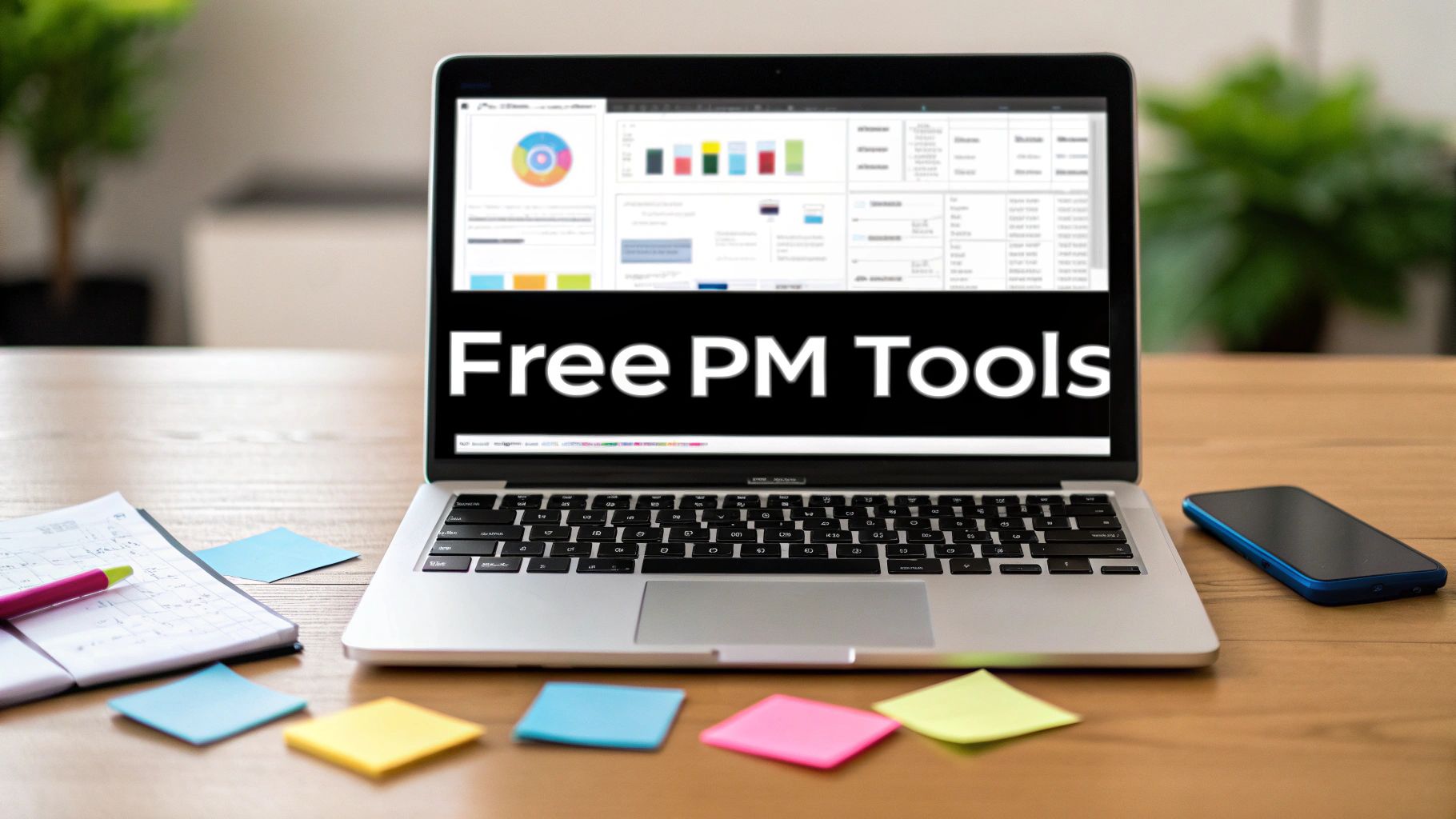12 Best Free Project Management Tools for B2B Teams (2025)
In the fast-paced world of B2B and SaaS, efficient project management is the backbone of growth, yet budget constraints often make expensive software a non-starter. Juggling tasks, deadlines, and team collaboration without a dedicated system leads to missed milestones, communication breakdowns, and stalled progress. This is precisely the problem this guide solves. We've compiled a comprehensive list of the best free project management tools designed to bring structure and clarity to your workflows without impacting your bottom line.
This article cuts through the noise, providing a deep-dive analysis that goes beyond generic feature lists. For each platform, you will find actionable insights into its true capabilities, hidden limitations, and automation potential. We provide screenshots and direct links to help you evaluate each option quickly. You'll learn which tool is best suited for agile software teams, which excels at creative content workflows, and how to select a platform that can scale with your business without forcing a premature, costly upgrade. While our focus is on project-specific platforms, understanding the broader category of remote team management tools can provide additional context on available solutions for distributed teams.
Our goal is to equip you with the knowledge to make an informed decision. We will explore how to integrate these tools with your existing CRM and even leverage AI to automate tedious tasks, ensuring you maximize productivity from day one. This guide is your definitive resource for finding a powerful, free solution to manage your projects, streamline operations, and drive sustainable growth for your business.
1. Trello (Atlassian)
Trello is a cornerstone in the world of the best free project management tools, renowned for its intuitive, visual Kanban board system. It transforms project workflows into a series of boards, lists, and cards, which you can drag and drop to reflect progress. This simplicity is its greatest strength, making it exceptionally easy for new teams to adopt without a steep learning curve. The free plan is surprisingly robust, offering unlimited cards, members, and activity logs.

Its real power for B2B and SaaS teams lies in its extensibility. The free tier now includes Unlimited Power-Ups, allowing you to integrate apps like Slack, Google Drive, and Salesforce directly into your boards. This transforms a simple task board into a central command center for specific workflows. Butler, Trello's built-in automation tool, also allows for a limited number of command runs per month on the free plan, perfect for automating repetitive tasks like moving cards or adding checklists.
Key Features & Limitations
| Feature | Free Plan Details |
|---|---|
| Collaborators | Up to 10 per Workspace |
| Boards | Unlimited personal boards, 10 team boards |
| Automations | 250 Workspace command runs per month |
| Integrations | Unlimited Power-Ups |
| Views | Board view only (No Timeline, Calendar, or Dashboard) |
Best For & Practical Tips
Trello excels for marketing content pipelines, simple sales CRMs, and onboarding new hires.
- Pro Tip: Use labels strategically to categorize tasks (e.g., by priority, department, or client). Create a "Template" card with standard checklists and attachments that you can easily duplicate for recurring tasks. Explore how Trello fits into a broader strategy by checking out this workflow management software comparison.
While its 10-collaborator limit can be a constraint for growing teams, its user-friendly interface and strong mobile apps make it a top contender for small teams and straightforward projects.
Website: https://trello.com
2. Asana
Asana stands out among the best free project management tools by offering a more structured approach to task management. While many tools focus on a single view, Asana's free plan provides List, Board, and Calendar views, allowing teams to visualize work in the way that best suits their workflow. This flexibility makes it a powerful choice for projects that demand more than a simple Kanban board, offering clarity on tasks, assignees, and deadlines from multiple perspectives.
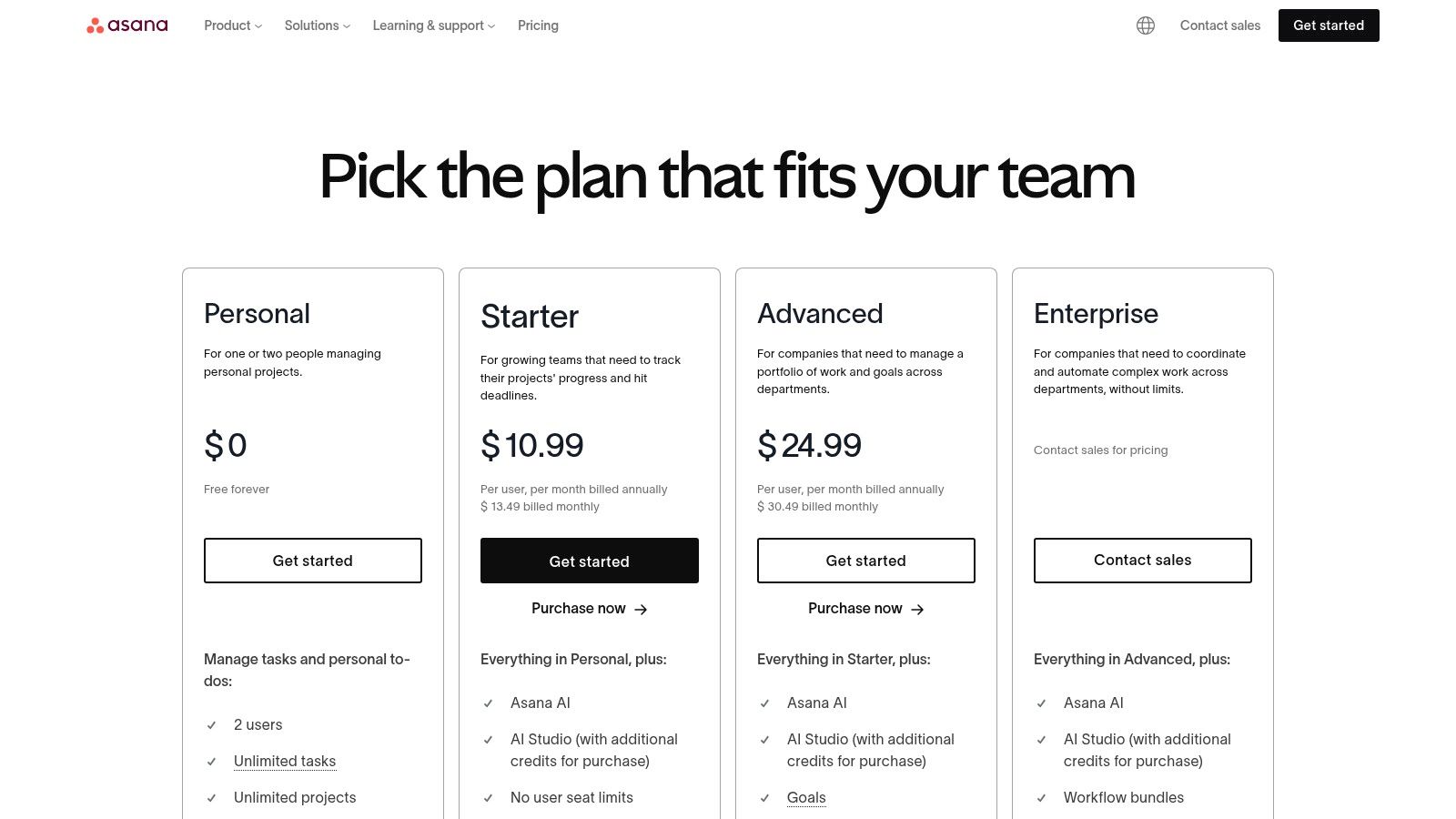
The platform is designed for clarity and accountability. Its free Personal plan is generous, offering unlimited tasks, projects, and storage for individuals or pairs. For B2B and SaaS teams, this makes it an excellent starting point for organizing complex initiatives before scaling to paid plans. The platform also boasts over 100 free integrations with popular apps like Microsoft Teams, Slack, and Gmail, ensuring it can fit neatly into an existing tech stack without any cost.
Key Features & Limitations
| Feature | Free Plan Details |
|---|---|
| Collaborators | Up to 15 team members |
| Projects | Unlimited projects, tasks, and activity log |
| Automations | Basic rules and automations available |
| Integrations | 100+ free integrations |
| Views | List, Board, and Calendar views (No Timeline or Portfolios) |
Best For & Practical Tips
Asana is ideal for detailed project planning, content calendar management, and client work tracking.
- Pro Tip: Use the "My Tasks" view as your daily command center. It automatically aggregates all tasks assigned to you across different projects, helping you prioritize your day. Asana is also a leader in incorporating AI, which you can read about in this overview of AI-powered project management tools.
While the free plan's 15-member limit is generous, advanced features like custom fields, reporting, and timeline views require an upgrade. However, its robust core functionality and polished user experience make it a top-tier choice for teams needing structure and scalability.
Website: https://asana.com/pricing?utm_source=openai
3. ClickUp
ClickUp aims to be the "one app to replace them all," and its position as one of the best free project management tools reflects this ambition. It offers an all-in-one workspace that combines tasks, docs, chat, and goals. The Free Forever plan is exceptionally generous, providing unlimited tasks and members, making it ideal for teams looking for a feature-dense environment without an immediate subscription cost. Its high degree of customization allows users to tailor nearly every aspect of their workflow.
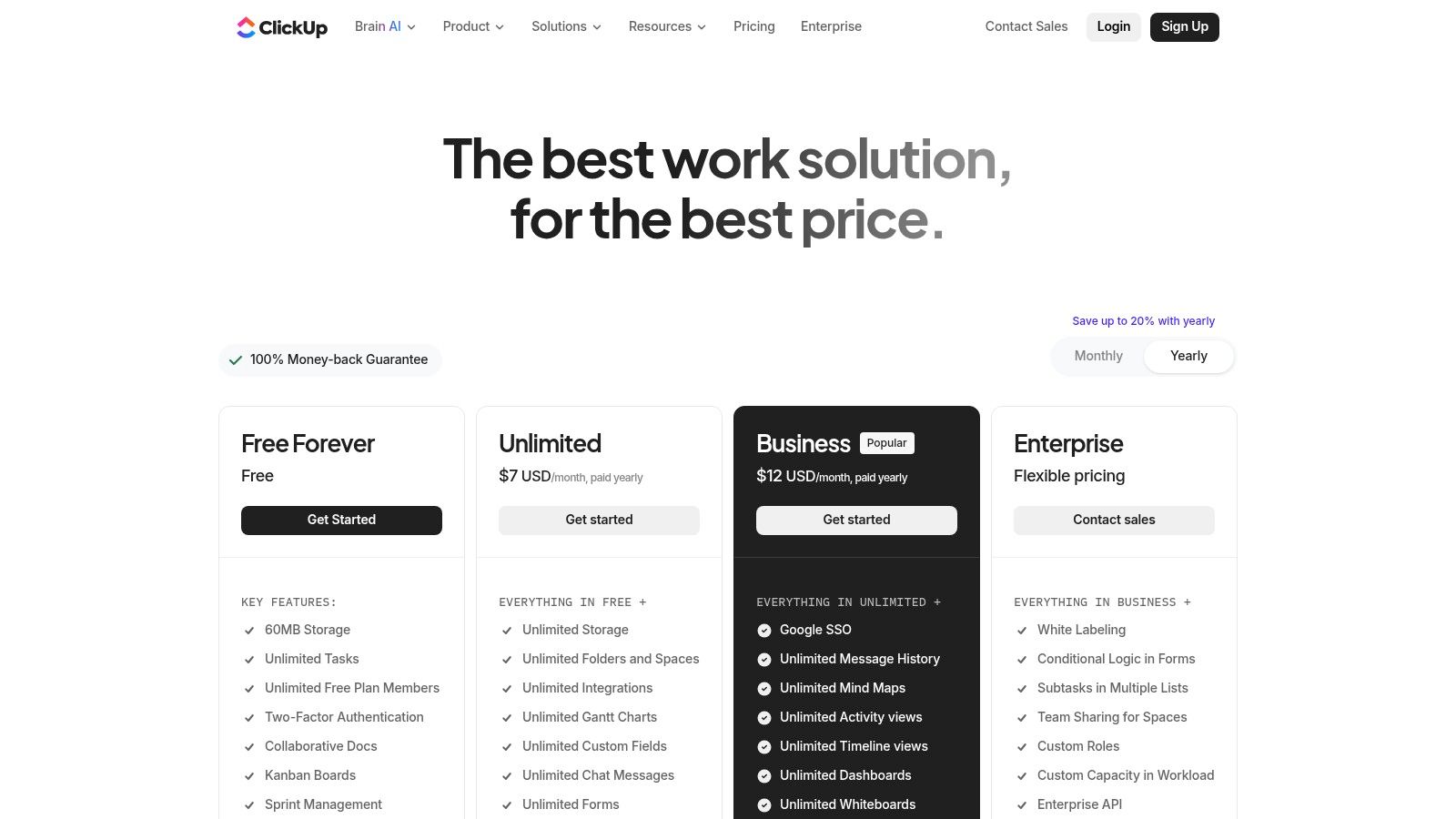
Unlike simpler tools, ClickUp provides multiple project views even on its free plan, including List, Board, and Calendar. This flexibility lets different team members work in the format they prefer. The platform also includes native Docs, allowing teams to create wikis, knowledge bases, and project briefs directly alongside their tasks. While the sheer number of features can present a steeper learning curve, its power makes it a scalable choice for teams planning for future growth.
Key Features & Limitations
| Feature | Free Plan Details |
|---|---|
| Collaborators | Unlimited free plan members |
| Tasks & Projects | Unlimited tasks and spaces |
| Automations | 100 automations per month |
| Storage | 100MB of file storage |
| Views | List, Board, Calendar views (No Gantt, Timeline, or Workload) |
Best For & Practical Tips
ClickUp is perfect for tech startups, agile development teams, and marketing agencies managing complex, multi-stage campaigns.
- Pro Tip: Start simple. Use one of ClickUp's pre-built templates for a specific use case (like content creation) to avoid getting overwhelmed. Use the "Everything" view to get a high-level overview of all tasks assigned to you across different projects. For a deeper analysis of how it stacks up, see this project management tools comparison.
While the free plan's storage and automation limits can be restrictive for heavy use, its comprehensive feature set and unlimited user capacity provide unmatched value for small teams with complex needs.
Website: https://clickup.com
4. monday.com Work Management
monday.com positions itself as a "Work OS," and while its free plan is limited, it serves as an excellent entry point into one of the most visually appealing and flexible platforms on the market. It excels at providing a colorful, intuitive interface that makes project tracking feel less like a chore. The free tier is designed for individuals or duos, offering a taste of its powerful board customization and a library of over 200 templates for various workflows.

Unlike many tools that lock you into a single view, monday.com’s core strength is its adaptability, although advanced views like Gantt and Timeline are reserved for paid tiers. For those considering it as one of the best free project management tools, the primary value lies in experimenting with its structure for personal task management or very small, two-person projects. Its mobile apps are slick and fully functional, ensuring you can manage tasks on the go.
Key Features & Limitations
| Feature | Free Plan Details |
|---|---|
| Collaborators | Up to 2 seats (users) |
| Boards | Up to 3 boards |
| Templates | 200+ templates available |
| Integrations | Not available on the free plan |
| Views | Basic Board view (Kanban available) |
Best For & Practical Tips
The free plan is ideal for freelancers, students, or partners testing a project concept.
- Pro Tip: Use the templates extensively to understand the platform's potential before you consider upgrading. The "To-Do List" and "Simple Project Tracker" templates are great starting points. Link items between your three boards to create relationships between tasks, even without advanced automations.
While the 2-seat and 3-board limit is a significant constraint, it's a perfect sandbox for individuals to organize complex personal projects before committing to a paid plan for team collaboration.
Website: https://monday.com/pricing?utm_source=openai
5. Jira Software (Atlassian)
Jira Software is a powerhouse among the best free project management tools, especially for software development and technical teams. Built for agile methodologies, it provides robust frameworks for Scrum and Kanban out-of-the-box. Its free plan is designed for small teams, offering sophisticated tools like backlogs for sprint planning, customizable boards for tracking work, and insightful reports to monitor progress. The platform's strength lies in its highly configurable workflows and issue types, allowing teams to create a process that perfectly matches their development cycle.
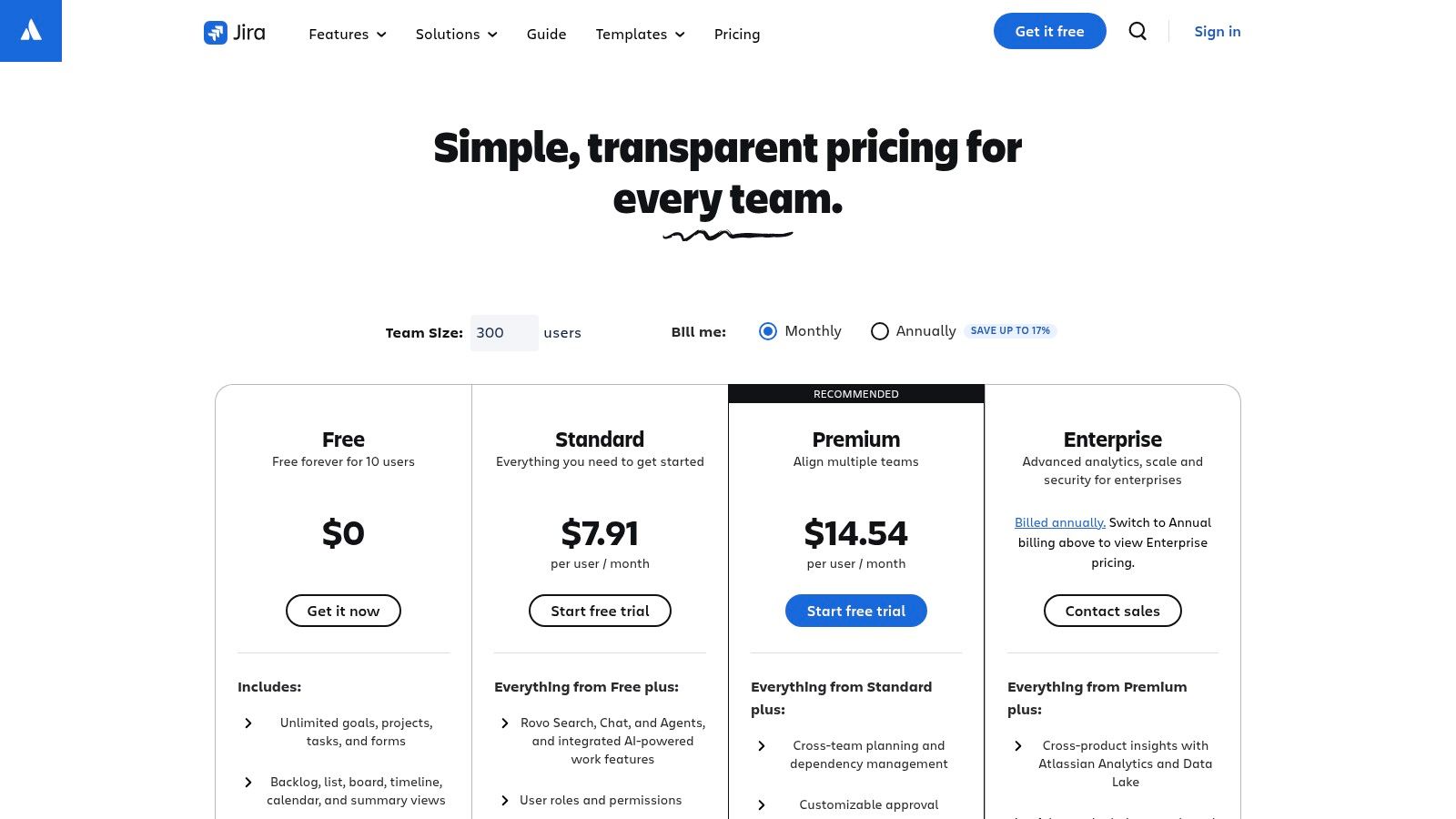
While Trello excels in simplicity, Jira excels in depth. The free tier includes access to the Atlassian Marketplace, enabling integrations with thousands of developer tools like GitHub, Slack, and Jenkins. It also offers a limited number of automation runs, perfect for handling routine actions like transitioning issues or notifying stakeholders. This level of specialization makes it an indispensable tool for teams that need to manage complex software projects, track bugs, and plan product roadmaps with precision.
Key Features & Limitations
| Feature | Free Plan Details |
|---|---|
| Collaborators | Up to 10 users |
| Storage | 2 GB file storage |
| Automations | 100 global and multi-project rule runs per month |
| Integrations | Atlassian Marketplace apps |
| Views | Backlog, Board, Timeline, Calendar |
Best For & Practical Tips
Jira is ideal for agile software development, bug tracking, and IT support ticket management.
- Pro Tip: Create custom issue types (e.g., 'Bug', 'Story', 'Task', 'Epic') to clearly define different kinds of work. Use JQL (Jira Query Language) in the advanced search to build powerful filters and custom dashboards that give you precise insights into project status.
Although its comprehensive feature set can present a steep learning curve for non-technical users, its scalability from small teams to enterprise-level organizations is unmatched.
Website: https://www.atlassian.com/software/jira/pricing?utm_source=openai
6. Wrike
Wrike is a robust work management platform designed for scalability, making it one of the best free project management tools for teams planning for future growth. Its free plan offers a solid foundation for centralized task management, allowing teams to organize projects, track to-dos, and collaborate effectively. While more limited than its paid counterparts, the free version provides a clean, professional interface that handles basic project needs with ease.
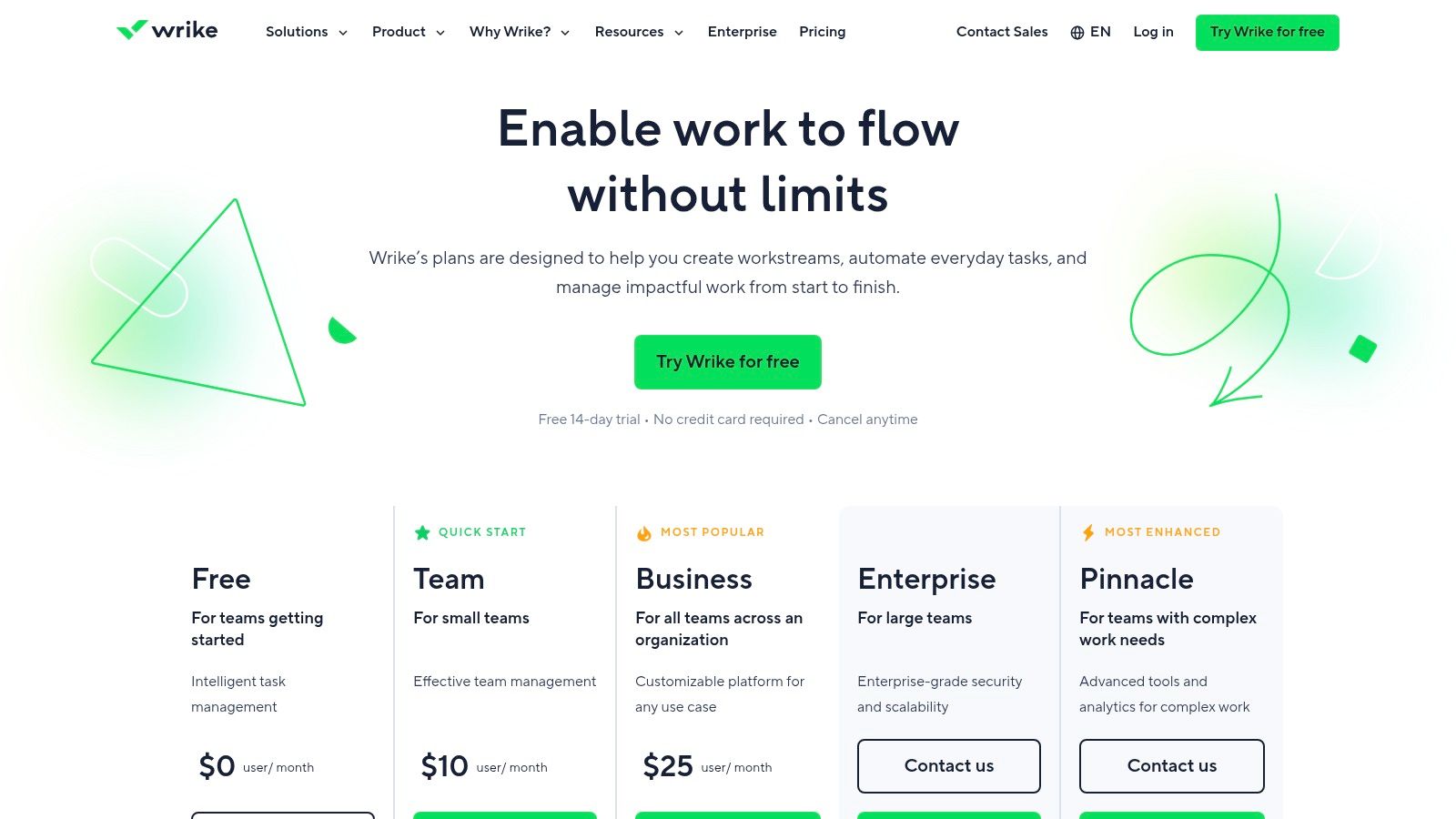
The platform's strength lies in its structured approach to work. Even on the free tier, users get access to task and subtask management, live activity streams, and integrations with cloud storage providers like Google Drive and Dropbox. This makes it an excellent starting point for small teams or departments that need a more traditional, folder-based project structure than what a simple Kanban board offers. The free plan is intentionally a gateway to Wrike's more powerful, feature-rich paid tiers.
Key Features & Limitations
| Feature | Free Plan Details |
|---|---|
| Collaborators | Unlimited users |
| Task Management | Full task & subtask management |
| Storage | 2 GB per account |
| Integrations | Core cloud storage, messaging, and calendar integrations |
| Views | Board and Table views only (No Gantt, Calendar, or Reports) |
Best For & Practical Tips
Wrike’s free plan is ideal for small teams managing straightforward projects who anticipate needing more advanced features like Gantt charts and custom reporting as they scale.
- Pro Tip: Use Wrike's folder structure to organize projects by client, department, or quarter. Within each project, use the Board view for a visual representation of the workflow and the Table view for a quick, spreadsheet-like overview of all tasks and their statuses.
While the free version lacks advanced views and automations, its unlimited user policy and enterprise-grade foundation make it a compelling choice for teams with an eye on the future.
Website: https://www.wrike.com/price/
7. Airtable
Airtable transcends the typical project manager, functioning as a powerful spreadsheet-database hybrid that makes it one of the best free project management tools for teams that need to build custom workflows from the ground up. It lets you link records between tables, create custom fields, and design sophisticated data models without writing any code. This flexibility allows teams to move beyond simple task lists and build bespoke systems for anything from content calendars to lightweight bug tracking.
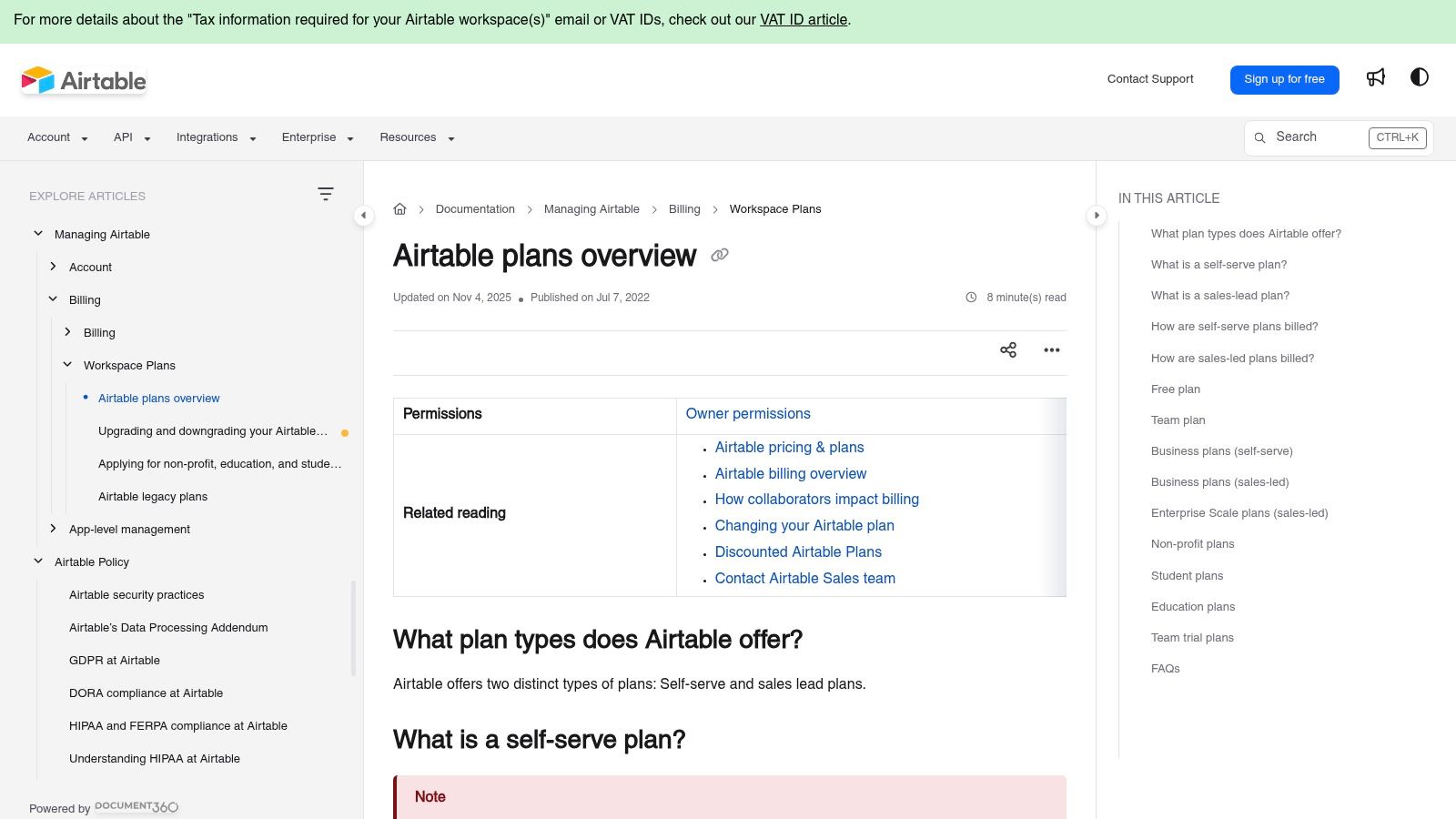
The free plan provides a solid foundation with unlimited bases (the Airtable equivalent of projects), though it imposes limits on records and storage. Unlike many competitors that restrict views, Airtable's free tier includes Grid, Kanban, and Calendar views, giving you multiple ways to visualize your project data. Its clean, approachable interface belies the complexity it can handle, making it a great choice for data-driven project managers who find traditional tools too rigid for their specific operational needs.
Key Features & Limitations
| Feature | Free Plan Details |
|---|---|
| Collaborators | Up to 5 editors per base |
| Records & Storage | 1,000 records & 1 GB of attachments per base |
| Automations | 100 runs per month |
| Integrations | Basic integrations with tools like Slack and email |
| Views | Grid, Kanban, Calendar, Form, and Gallery views included |
Best For & Practical Tips
Airtable is ideal for managing digital asset libraries, creating complex content production calendars, and building custom lightweight CRMs.
- Pro Tip: Use the "Link to another record" field type to create relationships between different data sets, such as linking tasks to specific clients or marketing campaigns. Leverage the Form view to create simple, shareable forms that feed data directly into your base for things like bug reports or content requests.
While the record and automation limits can be a challenge for high-volume projects, its unparalleled flexibility makes it a top-tier tool for teams wanting to craft their own perfect project management solution.
Website: https://support.airtable.com/v1/docs/airtable-plans?utm_source=openai
8. Zoho Projects
For small teams already invested in the Zoho ecosystem, Zoho Projects is a powerful and logical choice among the best free project management tools. It offers a more traditional, feature-rich project management experience compared to visual-first tools. The free plan provides a solid foundation with core task management, subtasks, and a collaborative whiteboard, making it suitable for structured, smaller-scale initiatives. Its true advantage is the seamless integration with other Zoho apps like Zoho CRM and Zoho Books, creating a unified business operating system.

While the free tier is generous for its user count, it gates many of the platform's signature features, such as Gantt charts, time tracking, and advanced reporting. The user interface can feel dense for newcomers, packing a lot of information into one view. However, this depth is also a strength for teams that need granular control and detailed project oversight from day one, with a clear and affordable upgrade path as their needs grow more complex.
Key Features & Limitations
| Feature | Free Plan Details |
|---|---|
| Collaborators | Up to 3 users |
| Projects | Up to 2 projects |
| Storage | 10MB file storage |
| Key Features | Task management, Project whiteboard, Basic task reports |
| Views | Classic view only (No Gantt, Resource, or Custom views) |
Best For & Practical Tips
Zoho Projects is ideal for small businesses or startups that use other Zoho products and need a structured, scalable project management solution.
- Pro Tip: Use the whiteboard feature for brainstorming sessions and initial project planning before breaking ideas down into structured tasks. If you are already using Zoho CRM, leverage the integration to automatically create projects from closed deals, streamlining your sales-to-delivery handoff process.
The 2-project and 3-user limit makes the free plan best suited for managing a couple of core internal initiatives or client projects before committing to a paid plan.
Website: https://www.zoho.com/projects/zohoprojects-pricing.html?utm_source=openai
9. Notion
Notion has evolved from a note-taking app into a powerful, all-in-one workspace that stands out among the best free project management tools. It merges documents, databases, and task management into a single, highly customizable environment. Instead of separate tools for wikis, roadmaps, and tasks, Notion allows you to build a connected system where a project brief can live right alongside its corresponding Kanban board. The free plan is generous for individuals and small teams, offering unlimited pages and blocks.
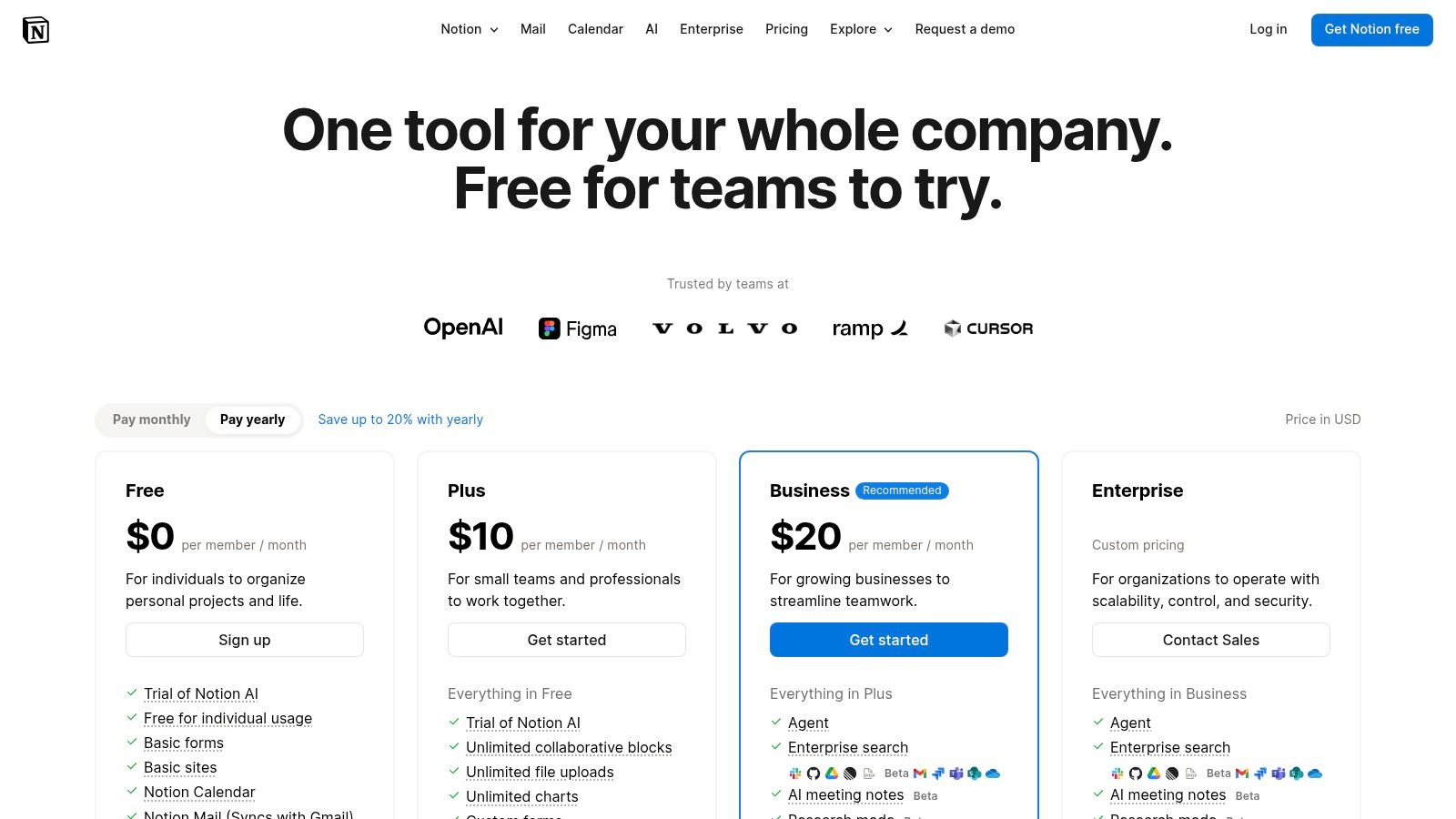
Its core strength is its flexibility. You can create simple to-do lists or build complex, relational databases to track multifaceted projects. For B2B teams, this means you can construct a lightweight CRM, a content calendar, and an internal knowledge base that all link together seamlessly. The free plan provides API access, allowing integrations with tools like Slack and GitHub to centralize information flow, though advanced features and team-specific controls are reserved for paid tiers.
Key Features & Limitations
| Feature | Free Plan Details |
|---|---|
| Collaborators | Up to 10 guests |
| Databases | Unlimited pages & blocks, with database views (Board, List, Calendar) |
| History | 7-day page history |
| Integrations | Public API access included |
| File Uploads | 5 MB per file |
Best For & Practical Tips
Notion is ideal for teams that need to combine project tracking with extensive documentation, like product development or content marketing.
- Pro Tip: Leverage Notion's vast template community to jumpstart your setup. Search for "project management" or "content calendar" templates to find pre-built systems you can adapt. Use database relations to link tasks directly to meeting notes or project goal pages for complete context.
While the free plan's file upload limit and short version history can be restrictive for asset-heavy projects, its unmatched customization makes it a top choice for creating a bespoke project hub.
Website: https://www.notion.com/pricing?utm_source=openai
10. OpenProject (Community Edition)
For teams that prioritize data sovereignty and technical control, OpenProject’s Community Edition is one of the best free project management tools available. This powerful, open-source platform is self-hosted, granting you complete control over your data and infrastructure. It offers an impressive suite of features for both classic (waterfall) and agile methodologies, including Gantt charts, agile boards, and project wikis, all without any user or project limits.
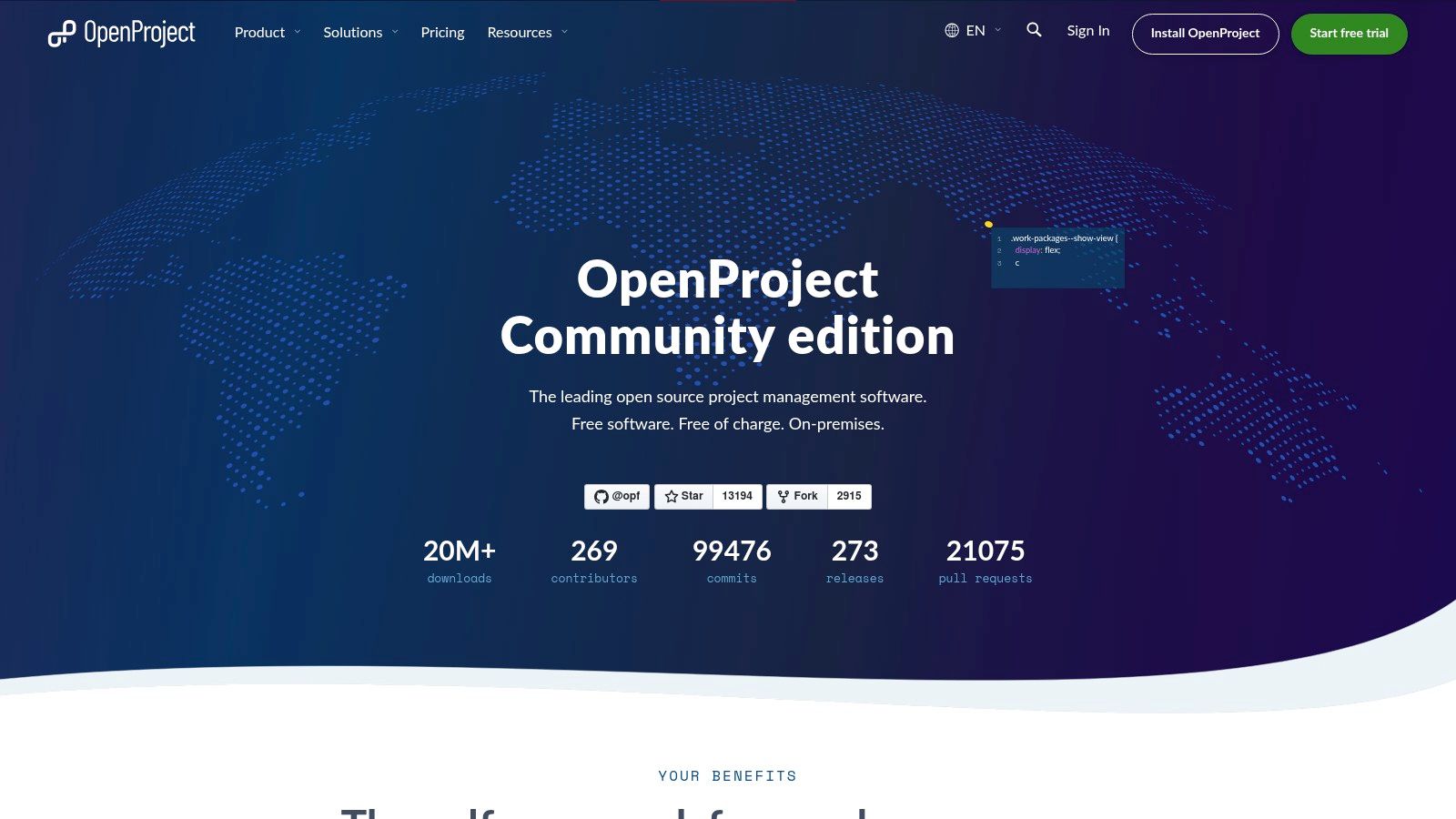
The primary trade-off for this freedom is the need for technical expertise. Unlike cloud-based SaaS tools, you are responsible for deploying, maintaining, and updating the software on your own servers. However, for organizations with IT resources, this model provides unparalleled security, customization via its REST API, and eliminates per-user subscription costs entirely. Its active community ensures regular updates and a solid support base for troubleshooting.
Key Features & Limitations
| Feature | Free Plan Details |
|---|---|
| Collaborators | Unlimited users, projects, and tasks |
| Hosting | Self-hosted only (on-premises) |
| Key Features | Gantt charts, Agile boards, Budgets, Wikis, Time tracking |
| Integrations | Via REST API; lacks premium integrations |
| Support | Community forums only (no official support) |
Best For & Practical Tips
OpenProject excels for engineering teams, public sector organizations, or any company with strict data privacy requirements.
- Pro Tip: Deploy OpenProject using Docker for a more streamlined installation and update process. Regularly back up your instance to prevent data loss, and leverage the project wiki feature to create a centralized knowledge base for all project documentation and SOPs.
While it requires an initial investment in setup and ongoing maintenance, the long-term benefit of a no-fee, fully-owned project management system is a compelling advantage.
Website: https://www.openproject.org/community-edition/?utm_source=openai
11. Freedcamp
Freedcamp stands out among the best free project management tools for its exceptionally generous free plan, which offers unlimited projects, tasks, and users. This makes it an ideal entry point for startups, nonprofits, or any team that needs robust core features without an immediate budget. Its interface consolidates essential modules like tasks, a calendar, files, and milestones into one central hub, providing a comprehensive project overview from the start.
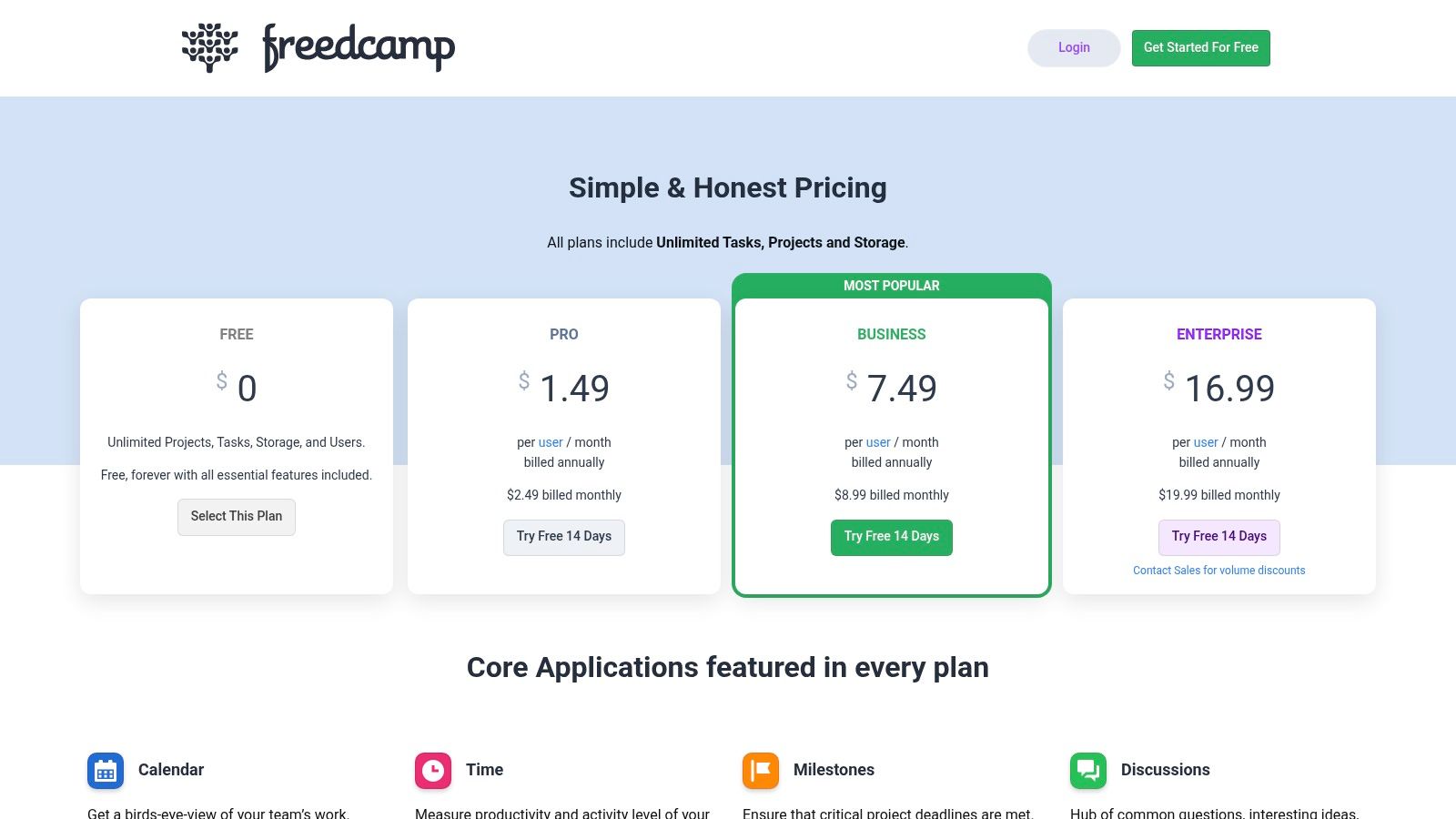
While the user interface might feel less modern than some competitors, its functionality is deep. The platform is designed as a suite of tools you can activate as needed, including a discussion board and time tracking, even on the free tier. This modular approach allows teams to start simple and add complexity later. The free plan also includes the ability to bring in guests and read-only collaborators, a feature often paywalled by other services.
Key Features & Limitations
| Feature | Free Plan Details |
|---|---|
| Collaborators | Unlimited users, guests, and read-only access |
| Projects | Unlimited |
| File Storage | 10 MB per file |
| Integrations | Web access only (Paid plans for Zapier, Google Drive, etc.) |
| Views | Tasks List, Kanban Board, Calendar (No Gantt or Reports) |
Best For & Practical Tips
Freedcamp is excellent for small agencies managing multiple client projects and nonprofits coordinating volunteer efforts on a tight budget.
- Pro Tip: Use the Milestones feature to set major project deadlines and link task lists to them. This creates a clear roadmap for stakeholders to follow. Leverage the Discussions tab to keep all project-related conversations in one place, avoiding scattered email threads.
While advanced features like reporting, invoicing, and premium integrations are reserved for its very affordable paid plans, Freedcamp's free offering is one of the most complete solutions available for teams that need scale without the cost.
Website: https://freedcamp.com/pricing
12. Capterra – Free Project Management Software Category
Instead of being a single tool, Capterra serves as a comprehensive discovery platform, making it an invaluable resource in the hunt for the best free project management tools. It’s a B2B software marketplace that aggregates hundreds of options, allowing you to filter specifically for vendors that offer a "Free version." This approach saves immense time by consolidating your initial research into one place.
The platform's strength lies in its verified user reviews and detailed feature comparisons. For B2B and SaaS teams, this is crucial for gauging how a tool performs in real-world scenarios beyond the marketing copy. You can see how others rate key aspects like ease of use, customer support, and value for money, providing a neutral, crowd-sourced perspective that helps you create a shortlist of candidates to test directly.
Key Features & Limitations
| Feature | Free Plan Details |
|---|---|
| Tool Discovery | Access to hundreds of software listings |
| Filtering | Dedicated filter for "Free version" and "Free trial" |
| Reviews | Thousands of verified user reviews and ratings |
| Comparisons | Side-by-side tool comparison functionality |
| Information Accuracy | Listings are vendor-managed; details can occasionally be outdated |
Best For & Practical Tips
Capterra is best for the initial research and comparison phase of selecting a new project management tool.
- Pro Tip: Use the "Compare" feature to select up to four tools and see their features, pricing models, and user ratings presented side-by-side. Always cross-reference the features and limitations listed on Capterra with the official vendor website, as pricing tiers can change frequently.
While it's a directory and not a functional PM tool itself, its role in making an informed decision is indispensable for any team looking to adopt the right free software from the start.
Website: https://www.capterra.com/project-management-software/s/free/?utm_source=openai
Top 12 Free Project Management Tools — Feature Comparison
| Product | Core features | Free plan limits (price) | Target audience | USP / Why choose |
|---|---|---|---|---|
| Trello (Atlassian) | Kanban boards, cards, Butler automations, mobile apps | Free: up to 10 collaborators per workspace | Small teams/simple projects, mobile users | Very low learning curve + large Power-Up ecosystem |
| Asana | List/board/calendar/timeline, templates, integrations | Free: up to 2 users, unlimited tasks/projects | Individuals or pairs needing structured workflows | Mature templates and structured task tracking |
| ClickUp | Tasks, Docs, Chat, Goals, multiple views | Free: unlimited tasks and free members | Small teams wanting an all-in-one, customizable workspace | Feature-rich free tier and deep customization |
| monday.com Work Management | Visual boards, templates, expandable automations | Free: up to 2 seats, 3 boards/docs | Individuals experimenting with templates | Friendly UI with many ready-made templates |
| Jira Software (Atlassian) | Backlogs, Scrum/Kanban boards, reports, marketplace | Free: up to 10 users, limited automation runs | Software and IT teams using agile workflows | Deep agile features and enterprise scaling |
| Wrike | Task/project management, file sharing, board view | Free: basic starter tier (limited features) | Teams needing solid collaboration and file handling | Good performance for larger projects |
| Airtable | Spreadsheet-database, Grid/Kanban/Calendar views | Free: 1,000 records/base, 1 GB attachments/base | Teams needing custom data models and catalogs | Extremely flexible data modeling and views |
| Zoho Projects | Tasks, subtasks, Gantt, whiteboard | Free: up to 5 users, 3 projects | SMBs and Zoho ecosystem users | Strong value and smooth upgrade path within Zoho |
| Notion | Pages + databases, Kanban boards, templates | Free: individual-focused, 7-day version history | Individuals/small teams combining docs + tasks | Combines knowledge base and task management |
| OpenProject (Community) | Tasks, timelines, agile boards, self-hosting | Free: Community Edition, unlimited users/projects | Organizations needing on-premises control | Full data sovereignty and no per-seat fees |
| Freedcamp | Tasks, calendar, milestones, optional add-ons | Free: unlimited users & projects (file limits apply) | Freelancers, nonprofits, budget-conscious teams | Extremely generous free tier and built-in modules |
| Capterra – Free PM Category | Reviews, feature breakdowns, vendor links | Free to use (marketplace) | Buyers researching free project-management options | Time-saving curated comparisons and real user reviews |
Beyond the Tool: Automating Your PM Workflows for Maximum ROI
Navigating the landscape of the best free project management tools can feel overwhelming, but as we've explored, the right platform is out there for every team, from agile development squads using Jira to creative agencies thriving on monday.com's visual workflows. We've dissected the nuances of Trello's simplicity, Asana's task dependency prowess, and ClickUp's all-in-one ambition. We've also highlighted the critical limitations of each free tier, ensuring you can make a choice that supports your operations today without creating a bottleneck tomorrow.
The key takeaway is that the tool itself is only half the equation. The true return on investment isn't found in a feature list; it's unlocked when you embed your chosen tool into a cohesive, automated ecosystem. Selecting a platform is just the first step on the path to operational excellence.
From Selection to Strategic Implementation
Choosing the right tool requires an honest assessment of your team's core needs. Don't be swayed by the platform with the most features; focus on the one that solves your most pressing problems with the least friction.
To help you move forward, consider these final guiding questions:
- What is your primary workflow? Are you managing a linear sales pipeline, a complex software development lifecycle, or a content creation calendar? Your answer will point you toward either a Kanban-focused tool like Trello, a Gantt-centric platform like Wrike, or a hybrid model like ClickUp.
- What does your tech stack look like? Your PM tool should not be an island. Evaluate its native integrations with your essential software, such as your CRM, communication channels (like Slack or Teams), and file storage. The fewer manual data transfers, the better.
- How much complexity can your team handle? A powerful tool like Jira or OpenProject is wasted if the team finds its interface intimidating. Prioritize user adoption. It's often more effective to start with a simpler tool and leverage its automation capabilities than to implement a complex system nobody uses.
The Power of Integrated and Automated Workflows
The most successful B2B and SaaS companies don't just use project management tools; they weaponize them through automation. The real competitive advantage emerges when you eliminate manual, repetitive tasks that drain your team's energy and focus.
Imagine these scenarios, all achievable with the tools we've discussed:
- Automated Project Kickoffs: A deal marked "Closed-Won" in your CRM automatically creates a new project in Asana, populates it with a standard project template, and assigns initial tasks to the onboarding team.
- AI-Powered Task Generation: A recorded client call is transcribed by a Voice AI, which then identifies action items and creates corresponding tasks in ClickUp, complete with due dates and assigned team members.
- Seamless Cross-Functional Handoffs: When a marketing task is moved to "Done" in Trello, a notification is automatically sent to the sales team's Slack channel, alerting them that new lead-generation assets are ready.
Building these interconnected systems is where the true value lies. By connecting your PM tool via its API or native integrations, you transform it from a passive task list into an active, intelligent hub for your entire operation. For teams looking to extend their automation capabilities even further or create custom solutions, exploring options like no-code app builders can offer valuable insights into building proprietary internal tools without extensive development resources.
Ultimately, your goal should be to create a system where work flows, information is synchronized, and your team is freed up to focus on high-impact, strategic initiatives. The best free project management tools are not just about organizing work; they are the foundation for building a truly scalable, efficient, and automated business engine.
Ready to transform your project management tool from a simple checklist into a fully automated growth engine? At MakeAutomation, we specialize in designing and implementing the sophisticated, end-to-end workflows that power modern B2B and SaaS businesses. Visit MakeAutomation to learn how we can help you connect your tools, eliminate manual work, and unlock your team's full potential.

